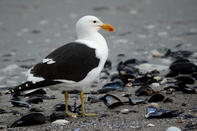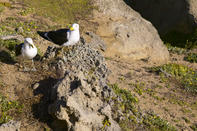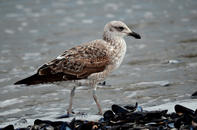While they tend to favour fish, worms, molluscs, eggs and smaller birds, Cape Gulls (Larus Vetula) may also prey on small livestock, such as sheep and calves.

The Cape Gull tends to stick to coastal areas and have black upperparts with white underparts, heads, necks and tails. The top of the wings, have white spots on the tip of the primaries, while the underparts are white with black near the ends.
Adults have dark eyes and a bright red spot on the tip of their otherwise yellow bills, which according to the Dutch scientist Niko Tinbergen, chicks peck when they want food.
Adult birds may have a wingspan of 128 cm to 142 cm and weigh 0,6 cm to 1,3 kg. Cape gulls are largely sedentary birds that stay in large colonies in coastal areas.
Apart from the Greater Cape Town area, they seldom occur more than a few kilometers inland. Birds of over 24 years have been recorded and even though they usually return to their natal colonies, some have been been found to fly over 1 211 km from their nesting grounds.
Killing and Feeding Pattern

Management

Seagulls are a protected species, so farmers need a permit to manage them. To prevent damages, however, it makes sense to reduce the availability of artificial food sources, through better waste management. Trash cans should be secured, bird feeders should be removed and pet food containers should be moved inside.
The Predation Management manual suggests using audio and visual deterrents, such as reflectors or scarecrows, to scare birds away from vulnerable livestock and steps be taken to protect livestock when they are particularly vulnerable.
Pregnant ewes, for example, should be moved to smaller camps, where it is easier for a shepherd to look after them, a couple of weeks before lambing and should stay there for a few weeks after lambing, until they and their lambs are less vulnerable.
By Glenneis Kriel